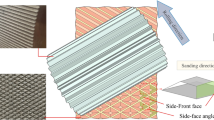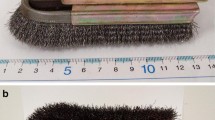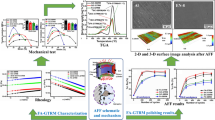Abstract
The abrasive sanding process is the most labor-intensive operation in the Rubberwood furniture manufacturing industry. Although the machining properties of Rubberwood (Hevea brasiliensis) are well established, information on its abrasive sanding characteristics is sparse. This study was carried out to establish the optimal abrasive sanding regime for Rubberwood. The results suggest that the abrasive sanding process can be optimized when well machine-planed Rubberwood stocks are used. Further, it was found that when the machine surface quality was good, abrasive sanding with a two-level sequence of grit sizes was sufficient to produce an acceptable surface smoothness. The improved surface smoothness also minimized the coating film spread on the wood surface. This finding will serve as a useful benchmark for machine-planing and abrasive sanding processes in the high-volume Rubberwood furniture manufacturing industry.
Zusammenfassung
Das Schleifen ist der aufwändigste Arbeitsvorgang bei der Herstellung von Möbeln aus Gummibaumholz (Hevea Brasiliensis). Obgleich seine Be- und Verarbeitungseigenschaften im Großen und Ganzen erfasst sind, sind die Informationen hinsichtlich der Schleifeigenschaften noch spärlich. Die vorliegende Untersuchung wurde durchgeführt, um den Schleifvorgang von Gummibaumholz zu optimieren. Die Ergebnisse weisen darauf hin, dass der Schleifvorgang durch Verwendung von maschinell gut vorgehobeltem Gummibaumholz optimiert werden kann. So zeigte sich, dass für eine gut gehobelte Oberflächenqualität ein zweifacher Schleifvorgang mit unterschiedlicher Korngröße ausreichte, um eine akzeptable Oberflächenglätte zu erzielen. Die so verbesserte Oberflächenqualität ermöglicht darüber hinaus die Minimierung der benötigten Beschichtung. Diese Erkenntnis setzt einen wertvollen Maßstab für das Hobel- und Schleifverfahren für die wirtschaftlich bedeutende Möbelherstellung aus Gummibaumholz.







Similar content being viewed by others
References
Ahola P (1991) Adhesion between paint and wood substrate. JOCCA 74:173–176
Akubulut T, Hiziroglu S, Ayrilmis N (2000) Surface absorption, surface roughness and formaldehyde emission of turkish medium density fiberboard. Forest Prod J 50(6):45–48
Franz NC, Hinken EW (1954) Machining wood with coated abrasives. Forest Prod J 4(10):251–254
Hiziroglu S (1996) Surface roughness analysis of wood composites: a stylus method. Forest Prod J 46(7/8):67–72
Hoff K, Fisher N, Miller S, Webb A (1997) Sources of competitiveness for secondary wood products firms: a review of literature and research issues. Forest Prod J 47(2):31–37
Hong LT, Sim HC (1994) Rubberwood: processing and utilization. FRIM, Malaysia
Koch P (1964) Wood machining processes. Ronald Press, New York
Lavery DJ, Larnon DM, Taylor JM, Maloney S, Atanackovic A (1995) Parameters affecting the surface finish of planed Sitka Spruce. Forest Prod J 45(4):45–50
Nagyszalanczy S (1997) The wood sanding book. Taunton Press, New York
Murmanis L, River BH, Stewart HA (1986). Surface and subsurface characteristics related to abrasive-planing conditions. Wood Fiber Sci 18(1):107–117
Lavery DJ, Larnon DM, Taylor JM, Maloney S, Atanackovic A (1995) Parameters affecting the surface finish of planed Sitka Spruce. Forest Prod J 45(4):45–50
Peter CC, Cumming JD (1970) Measuring wood surface smoothness: a review. Forest Prod J 20(12):40–43
Ratnasingam J (2001) How smooth is smooth? Asian Timber 20(3):24–25
Ratnasingam J, Reid HF, Perkins MC (2002) The abrasive sanding of rubberwood (Hevea brasiliensis): an industrial perspective. Holz Roh- Werkstoff 60(3):191–196
Ratnasingam J, Tanaka C (2002) Wood machining processes—a managerial perspective. Tanabe Foundation, Japan
Ratnasingam J, Reid HF, Perkins MC (1997) Furniture industry: regaining the competitive edge. J Inst Wood Sci 14(3):115–120
Ratnasingam J, Reid HF, Perkins MC (1999) The productivity imperatives in coated abrasives application in furniture manufacturing. Holz Roh- Werkstoff 57:117–120
Richter K, Feist WC, Knaebe MT (1995) The effect of surface roughness on the performance of finishes. Part 1–roughness characterization and stain performance. Forest Prod J 45(7/8):91–97
Rijckaert V, Stevens M, Van Acker J (2001) Effect of some formulation parameters on the penetration and adhesion of water-borne primers into wood. Holz Roh- Werkstoff 59:344–350
Stewart HA (1974) A comparison of factors affecting power for abrasive and knife planing of hardwoods. Forest Prod J 24(3):31–34
Taylor JB, Carrano AL, Lemaster RL (1999) Quantification of process parameters in a wood sanding operation. Forest Prod J 49(5):41–46
Author information
Authors and Affiliations
Corresponding author
Rights and permissions
About this article
Cite this article
Ratnasingam, J., Scholz, F. Optimizing the abrasive sanding process of rubberwood (Hevea brasiliensis). Holz Roh Werkst 62, 411–418 (2004). https://doi.org/10.1007/s00107-004-0522-x
Published:
Issue Date:
DOI: https://doi.org/10.1007/s00107-004-0522-x




